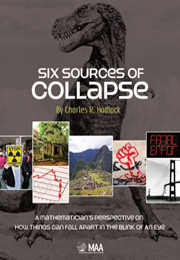 Six Sources of Collapse
Six Sources of Collapse What is a collapse?
Can you name ten occurrences that you would regard as “collapses”? Just think about this for a moment before reading on.
In case you're having any trouble getting to ten, let's think about categories: civilizations, empires, governments, economies, technologies, industries, companies, species, fads, styles, banks, buildings, bridges, cranes, just to name a few. No problem getting to ten now, right? And if you're getting up in years like me, you can probably recall seeing or hearing about at least ten in almost every single one of these categories, as well as others.
Can you think of any good, i.e., beneficial, collapses? If you grew up in a Western country during the Cold War, then the collapse of the Soviet Union might be one of the first items to come to mind. And then there's the collapse of major diseases such as smallpox and polio, or even the occasional mysterious collapse of cancerous tumors, often not fully understood. There are of course many more.
We may all have slightly different definitions of a “collapse,” but let's use the term loosely to refer to some relatively rapid process that leads to a significant reduction in quantity, quality, or level of organization. For example, we speak of the collapse of the dinosaurs, a process that may have taken up to several thousand years after a likely calamitous meteorite impact that significantly changed the Earth's environment; but this time period is still almost instantaneous when compared with the 160 million year period during which the dinosaurs were the dominant terrestrial vertebrates.
To save this book to your Kindle, first ensure no-reply@cambridge.org is added to your Approved Personal Document E-mail List under your Personal Document Settings on the Manage Your Content and Devices page of your Amazon account. Then enter the ‘name’ part of your Kindle email address below. Find out more about saving to your Kindle.
Note you can select to save to either the @free.kindle.com or @kindle.com variations. ‘@free.kindle.com’ emails are free but can only be saved to your device when it is connected to wi-fi. ‘@kindle.com’ emails can be delivered even when you are not connected to wi-fi, but note that service fees apply.
Find out more about the Kindle Personal Document Service.
To save content items to your account, please confirm that you agree to abide by our usage policies. If this is the first time you use this feature, you will be asked to authorise Cambridge Core to connect with your account. Find out more about saving content to Dropbox.
To save content items to your account, please confirm that you agree to abide by our usage policies. If this is the first time you use this feature, you will be asked to authorise Cambridge Core to connect with your account. Find out more about saving content to Google Drive.